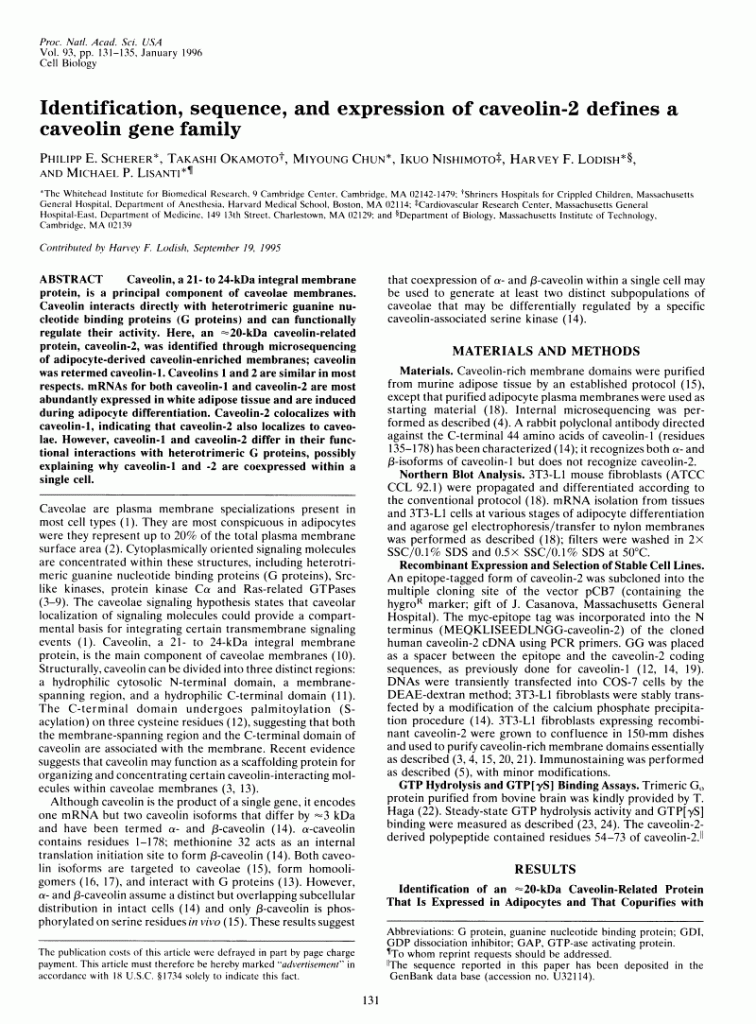Caveolae are microdomains of the plasma membrane which have been implicated in sign transduction. Caveolin, a 21-24-kDa integral membrane protein, is a principal component of the caveolae membrane.
Recently, we and others have recognized a household of caveolin-related proteins; caveolin has been retermed caveolin-1. Caveolin-3 is most carefully associated to caveolin-1, however caveolin-Three mRNA is expressed solely in muscle tissue varieties. Here, we study (i) the expression of caveolin-Three protein in muscle tissue varieties and (ii) its localization inside skeletal muscle fibers by immunofluorescence microscopy and subcellular fractionation.
For this function, we generated a novel monoclonal antibody (mAb) probe that acknowledges the distinctive N-terminal area of caveolin-3, however not different members of the caveolingenefamily.
A survey of tissues and muscle cell varieties by Western blot evaluation reveals that the caveolin-Three protein is selectively expressed solely in coronary heart and skeletal muscle tissues, cardiac myocytes, and smooth muscle cells.

Immunolocalization of caveolin-3 in skeletal muscle fibers demonstrates that caveolin-3 is localized to the sarcolemma (muscle cell plasma membrane) and coincides with the distribution of one other muscle-specific plasma membrane marker protein, dystrophin. In addition, caveolin-Three protein expression is dramatically induced throughout the differentiation of C2C12 skeletal myoblasts in tradition.
Using differentiated C2C12 skeletal myoblasts as a mannequin system, we observe that caveolin-3 co-fractionates with cytoplasmic signaling molecules (G-proteins and Src-like kinases) and members of the dystrophin advanced (dystrophin, alpha-sarcoglycan, and beta-dystroglycan), however is clearly separated from the bulk of mobile proteins.
Caveolin-Three co-immunoprecipitates with antibodies directed towards dystrophin, suggesting that they’re bodily related as a discrete advanced. These outcomes are constant with earlier immunoelectron microscopic research demonstrating that dystrophin is localized to plasma membrane caveolae in smooth muscle cells.
Molecular cloning of caveolin-3, a novel member of the caveolin gene household expressed predominantly in muscle
Caveolin, a 21-24-kDa integral membrane protein, is a principal component of caveolar membranes in vivo. Caveolin interacts instantly with heterotrimeric G-proteins and can functionally regulate their exercise. Recently, a second caveolingene has been recognized and termed caveolin-2. Here, we report the molecular cloning and expression of a third member of the caveolingene gamily, caveolin-3.
Caveolin-3 is most carefully associated to caveolin-1 based mostly on protein sequence homology; caveolin-1 and caveolin-Three are roughly 65% equivalent and roughly 85% related. A single stretch of eight amino acids (FED-VIAEP) is equivalent in caveolin-1, -2, and -3. This conserved area could characterize a “caveolin signature sequence” that is attribute of members of the caveolingenefamily. Caveolin-Three mRNA is expressed predominantly in muscle tissue-types (skeletal muscle, diaphragm, and coronary heart) and is selectively induced throughout the differentiation of skeletal C2C12 myoblasts in tradition. In many respects, caveolin-3 is much like caveolin-1:
(i) caveolin-Three migrates in velocity gradients as a excessive molecular mass advanced; (ii) caveolin-Three colocalizes with caveolin-1 by immunofluorescence microscopy and cell fractionation research; and (iii) a caveolin-3-derived polypeptide functionally suppresses the basal GTPase exercise of purified heterotrimeric G-proteins.
Identification of a muscle-specific member of the caveolingenefamily could have implications for understanding the position of caveolin in completely different muscle cell varieties (smooth, cardiac, and skeletal) as earlier morphological research have demonstrated that caveolae are considerable in these cells.
Our outcomes additionally counsel that different as but unknown caveolinfamily members are more likely to exist and could also be expressed in a regulated or tissue-specific trend.
Caveolae are plasmalemmal microdomains which are concerned in vesicular trafficking and sign transduction. We have sought to determine novel integral membrane proteins of caveolae. Here we describe the identification and molecular cloning of flotillin.
By a number of unbiased strategies, flotillin behaves as a resident integral membrane protein component of caveolae. Furthermore, we now have recognized epidermal floor antigen each as a flotillin homologue and as a resident caveolar protein. Significantly, flotillin is a marker for the Triton-insoluble, buoyant membrane fraction in mind, the place up to now mRNA species for identified caveolingenefamily members haven’t been detected.
Caveolin, a 21- to 24-kDa integral membrane protein, is a principal component of caveolae membranes. Caveolin interacts instantly with heterotrimeric guanine nucleotide binding proteins (G proteins) and can functionally regulate their exercise. Here, an roughly 20-kDa caveolin-related protein, caveolin-2, was recognized via microsequencing of adipocyte-derived caveolin-enriched membranes;
caveolin was retermed caveolin-1. Caveolins 1 and 2 are related in most respects. mRNAs for each caveolin-1 and caveolin-2 are most abundantly expressed in white adipose tissue and are induced throughout adipocyte differentiation. Caveolin-2 colocalizes with caveolin-1, indicating that caveolin-2 additionally localizes to caveolae. However, caveolin-1 and caveolin-2 differ in their practical interactions with heterotrimeric G proteins, probably explaining why caveolin-1 and -2 are coexpressed inside a single cell.
